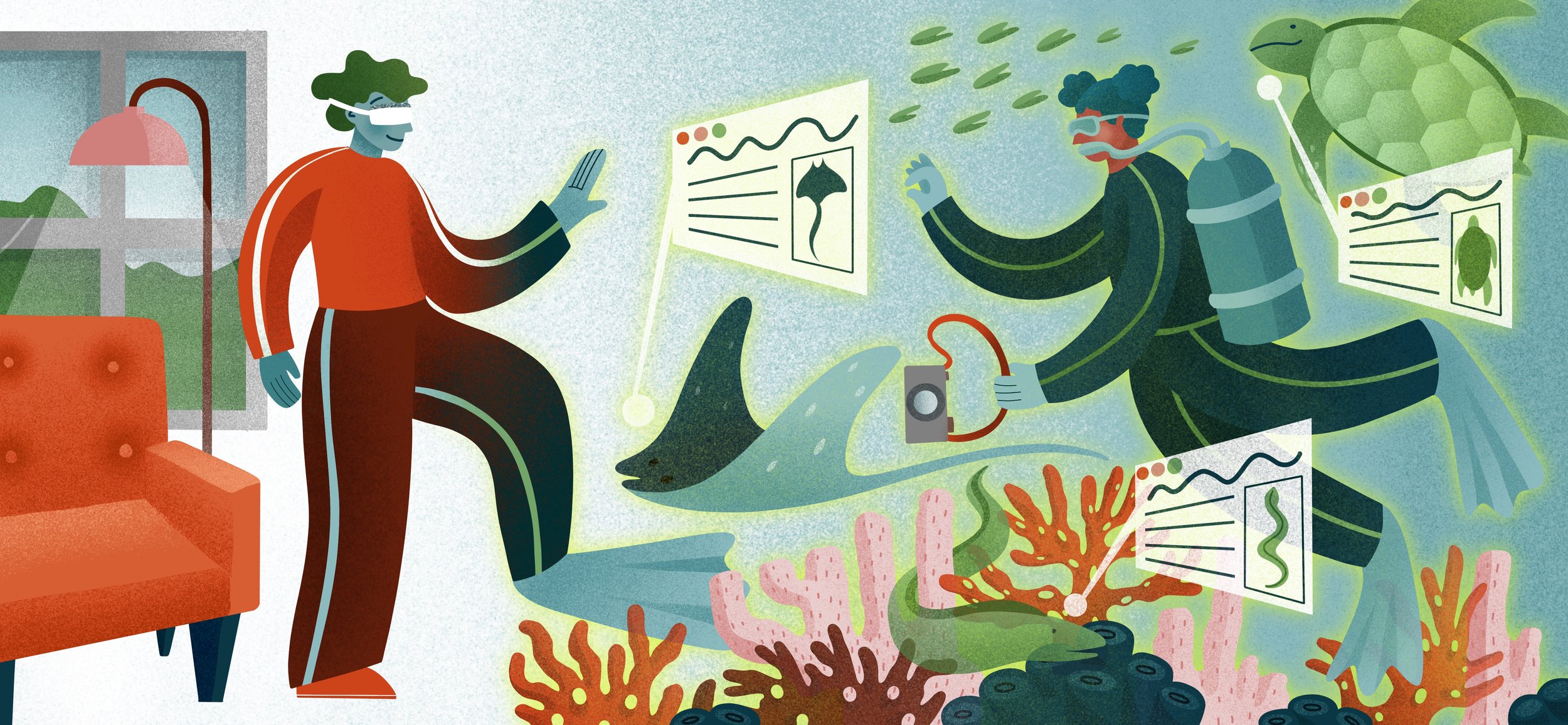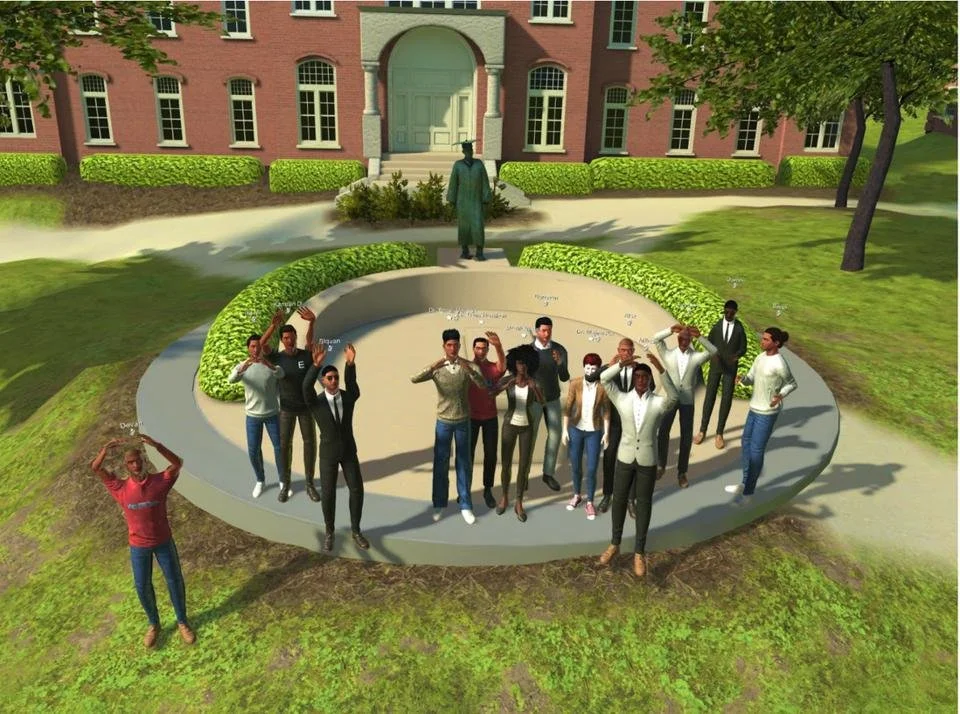What is VR?
You’ve heard the term, you’ve seen the headsets, and you may have even tried out an experience or two. VR, or virtual reality, has very much become part of our actual reality, thanks in no small part to the rise of the Metaverse. But what exactly is it?
The TLDR on VR
We can define virtual reality (VR) as a sum of its parts. Virtual, in this sense, means “near,” whereas reality describes the world in which we live. VR, then, is effectively near our world. From a technical standpoint, VR is applied to a range of 3D, computer generated environments that we can interact with and explore. Most VR experiences today depend on headsets or projections that create not only visuals, but also sounds and other sensory experiences that simulate your existence in an alternate (but near!) reality.
Characteristics of VR
Just as there is a spectrum of virtuality when it comes to extended reality (XR) — which is an umbrella term that includes AR (augmented reality), MR (mixed reality), and VR — there is also a range of flavors within each of these categories. While classifications are not standardized, VR experiences are often distinguished based on their level of immersion, interactivity, and/or technology used.
VR experiences can range from non immersive screen-based video games to fully immersive experiences, where all of your real world senses are virtually stimulated using a mix of next gen technologies such as haptic bodysuits that can recreate the sense of touch, temperature, and more 🤯 .
The majority of popular VR experiences, however, lie somewhere in the middle — you slip on an HMD, or head mounted device (aka VR headset), and are transported to a virtual audio-visual world. Some experiences are more game-engine based and you can engage with this world, while others are more cinematic and you are more of an observer inside a 360-degree story (like the virtual coral reef dive below).
Regardless of the type of VR experience, according to Sherman and Craig (2003), they all share four characteristics:
Virtual World
The experience is computer-generated vs. fabricated like the stage design of a theater experience. Certain theatric elements can enhance a virtual reality experience, however, as demonstrated by the power of the Carne Y Arena immersive VR refugee border crossing experience.
Immersion
Users feel a sense of presence or “being there.”
Sensory feedback
User input creates a sensory result, such as moving your head to view a different part of the virtual world.
Interactivity
The ability to move within and engage with the virtual world, including the people and objects within it.
Types of VR Technology
Virtual reality experiences are only as good as the technology involved. The hardware end users put on or wear, and the software creators use to develop VR experiences are rapidly improving, both from a quality and accessibility perspective, but there is still significant room to grow.
Head Mounted Displays
Perhaps the most famous and certainly recognizable form of VR includes an HMD, or a head-mounted display (also commonly called a VR headset), which fully immerses the user into a new world. These headsets generally feature two monitors – one for each eye – that carefully render a three-dimensional environment. They’re paired with an audio system as well as head tracking that allows you to, quite literally, look around your new world. Some VR sets also come with handheld motion controls that allow you to pick up, put down, or otherwise interact with your new environment. Popular HMDs include:
Projectors
With the right placement of projectors (often multiple projectors), experts can effectively create a virtual environment for folks to interact with. Often referred to as CAVEs, or cave automatic virtual environments, they typically require some form of headset, special pair of glasses, or handheld controller in order to create the full experience. Artist Refik Anadol’s Archive Dreaming experience below is a good example of this.
Applications of VR
As VR has become more widespread and accessible, so too have its applications. Whereas the technology was previously used almost exclusively for and by well-funded industries including medicine, aviation, and the military, the commercialization of VR has resulted in a wide range of use cases. These include:
Learning & Education
From grade school to graduate school, virtual reality is becoming a powerful pedagogical instrument. Morehouse College has even begun offering classes in virtual reality, allowing students to walk through a virtual campus, collaborate with peers no matter where they’re located, and learn free from the constraints of the “real” world.
And for the lifelong learners among us, organizations like ours are creating experiences that can take you from the depths of the ocean to outer space. As education becomes more accessible through VR, we can provide opportunities for discovery and curiosity to students of all backgrounds.
Healthcare
For years, healthcare providers and professionals have used VR to help prepare them for complex procedures and for delivering trainings and lesson plans. Today, platforms like Osso VR help surgeons interact with medical devices in a virtual world and “operate” on virtual persons.
In late 2021, the FDA approved EaseVRx to help reduce pain in results by using cognitive behavioral therapy, deep relaxation, attention-shifting, interoceptive awareness, and more, all delivered via virtual reality platforms. This is part of a broader shift toward using VR to treat mental health issues – Virtual Reality Exposure Therapy has recently been lauded as a potential treatment for PTSD and anxiety.
Career Development
Large companies and startups alike are turning to VR to help train their workforces. Walmart was an early trailblazer, and has been training employees using virtual reality since 2018. More recently, Bank of America launched virtual reality training centers in over 4,000 locations. Virtual reality offers a safer space to learn, ask questions, and make mistakes. And while medical professionals may use VR for technical skills training, other applications are well within reach as well. VirtualSpeech, for example, leverages VR for soft skills, including public speaking, active listening, and sales.
Retail
Future shopping sprees don’t have to happen in stores and can transcend digital shopping carts. Increasingly, retailers are turning to virtual reality to help potential buyers experience their goods as though in real life. In March 2022, metaverse platform Decentraland hosted its first Metaverse Fashion Week fully in virtual reality, whereas brands including Gucci, Ralph Lauren, and Balenciaga have embraced VR, opening virtual pop-ups or digital only experiences.
Real estate
Clothes aren’t the only thing you can buy using virtual reality. Thanks to companies like Matterport, virtual reality is also allowing folks to tour homes and properties virtually. These are more than 3D tours on your desktop that allow you click around – instead, users are able to get a real feel for their potential new living quarters thanks to realistic full-building scans that are dimensionally accurate.
Entertainment
While VR videogames may be the most recognizable form of VR-based entertainment, there are plenty of other ways to leverage the technology for social purposes. MetaQuest, for example, has a whole host of VR-based entertainment, including immersive movies and TV shows, and there are a number of apps that will allow you to socialize with your friends via virtual reality as well.
In Conclusion…
Virtual reality allows its users to operate in and interact with a virtual environment, including other people and objects. While the most immersive of VR experiences require headsets, the recent spike in interest has resulted in many of these accessories becoming much more accessible and affordable. So if you’re looking for a way to go beyond the confines of this mortal coil, look no further than VR.
Geek Out With Us More
If you’re interested in digging into this topic even more, particularly from an educational perspective, we encourage you to review our evidence-based “Introduction to Learning the Metaverse” where we explore topics like the history of technology and education, when and how to integrate XR into learning, its pros and cons, and more!






